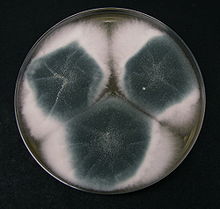Czapek medium

Aspergillus tubingensis growing on Czapek medium
Czapek medium, also called Czapek's agar (CZA)[1][2] or Czapek-Dox medium, is a growth medium for propagating fungi and other organisms in a laboratory. It was named after its inventors, Polish botanist Friedrich Johann Franz Czapek (May 16, 1868 - July 31, 1921) and American chemist Arthur Wayland Dox (September 19, 1882 - 1954). It was developed to grow Aspergillus niger[3] and Penicillium camemberti.[4] It works well for many saprophytic fungi and soil bacteria[5] such as species of Aspergillus, Candida, Penicillium, and Paecilomyces.[6]

Aspergillus bertholletius on Czapek agar
Friedrich Czapek's original recipe is as follows:[3]
- 1000 g distilled water
- 30 g cane sugar – energy source and sole source of carbon[5]
- 1 g monopotassium phosphate – buffering agent[5]
- 0.5 g magnesium sulfate – source of cations[5]
- 0.5 g potassium chloride – source of essential ions[5]
- 0.01 g iron sulfate – source of cations[5]

Aspergillus fumigatus on Czapek agar
Arthur Wayland Dox added 2 g of sodium nitrate in his version, to provide a sole source of nitrogen that is inorganic.[4] This makes the medium a selective growth medium as only organisms that can use inorganic nitrogen can grow.[6] Czapek and Dox did not add agar but many recipes add 15 g to make a solid medium.[5][6]
References
^ "Czapek Agar (CZA) Recipe". theLabRat.com. theLabRat.com. 2005. Retrieved 7 November 2017.Czapek Agar (CZA) Recipe
.mw-parser-output cite.citation{font-style:inherit}.mw-parser-output .citation q{quotes:"""""""'""'"}.mw-parser-output .citation .cs1-lock-free a{background:url("//upload.wikimedia.org/wikipedia/commons/thumb/6/65/Lock-green.svg/9px-Lock-green.svg.png")no-repeat;background-position:right .1em center}.mw-parser-output .citation .cs1-lock-limited a,.mw-parser-output .citation .cs1-lock-registration a{background:url("//upload.wikimedia.org/wikipedia/commons/thumb/d/d6/Lock-gray-alt-2.svg/9px-Lock-gray-alt-2.svg.png")no-repeat;background-position:right .1em center}.mw-parser-output .citation .cs1-lock-subscription a{background:url("//upload.wikimedia.org/wikipedia/commons/thumb/a/aa/Lock-red-alt-2.svg/9px-Lock-red-alt-2.svg.png")no-repeat;background-position:right .1em center}.mw-parser-output .cs1-subscription,.mw-parser-output .cs1-registration{color:#555}.mw-parser-output .cs1-subscription span,.mw-parser-output .cs1-registration span{border-bottom:1px dotted;cursor:help}.mw-parser-output .cs1-ws-icon a{background:url("//upload.wikimedia.org/wikipedia/commons/thumb/4/4c/Wikisource-logo.svg/12px-Wikisource-logo.svg.png")no-repeat;background-position:right .1em center}.mw-parser-output code.cs1-code{color:inherit;background:inherit;border:inherit;padding:inherit}.mw-parser-output .cs1-hidden-error{display:none;font-size:100%}.mw-parser-output .cs1-visible-error{font-size:100%}.mw-parser-output .cs1-maint{display:none;color:#33aa33;margin-left:0.3em}.mw-parser-output .cs1-subscription,.mw-parser-output .cs1-registration,.mw-parser-output .cs1-format{font-size:95%}.mw-parser-output .cs1-kern-left,.mw-parser-output .cs1-kern-wl-left{padding-left:0.2em}.mw-parser-output .cs1-kern-right,.mw-parser-output .cs1-kern-wl-right{padding-right:0.2em}
^ "NRRL Medium No. 8 Czapek's Solution Agar ( CZA )" (PDF). ARS (NRRL) Culture Collection. Peoria, IL: ARS Culture Collection National Center for Agricultural Utilization Research. Retrieved 7 November 2017.Czapek’s Solution Agar ( CZA )
^ ab Czapek, F (1901–1902). "Untersuchungen über die Stickstoffgewinnung und Eiweifsbildung der Pflanzen" [Studies on nitrogen production and protein formation of plants] (PDF). Beiträge zur chemischen Physiologie und Pathologie (in German). 1 (12): 538–560. OCLC 1519369. Retrieved 2 October 2017.
^ ab Dox, Arthur Wayland (1910). "The intracellular enzyms of penicillium and aspergillus: with special reference to those of Penicillium camemberti" (PDF). Bulletin (United States Bureau of Animal Industry). 120: 37. OCLC 22281943. Retrieved 3 October 2017.
^ abcdefg "CZAPEK MEDIUM" (PDF). Thermo Fisher Scientific. Lenexa, KS: Remel. September 20, 2007. Retrieved 3 October 2017.
^ abc "CZAPEK-DOX AGAR". Hardy Diagnostics Instructions for Use. Santa Maria, CA: Hardy Diagnostics. Retrieved 3 October 2017.
External links
- Czapek Medium recipe
- Czapek solution agar recipe
- Czapek's Agar recipe
- Czapek-Dox Agar
This microbiology-related article is a stub. You can help Wikipedia by expanding it. |